Last week I provided an intro to wargaming naval actions in the Civil War. I wanted to provide a short description of three rulesets I’ve checked out. There are certainly way more rulesets out there than what I’m talking about here, I have just checked these out based on recommendations. These are three that I think most gamers would like – not necessarily saying one is better than the other.
Dawn of Iron
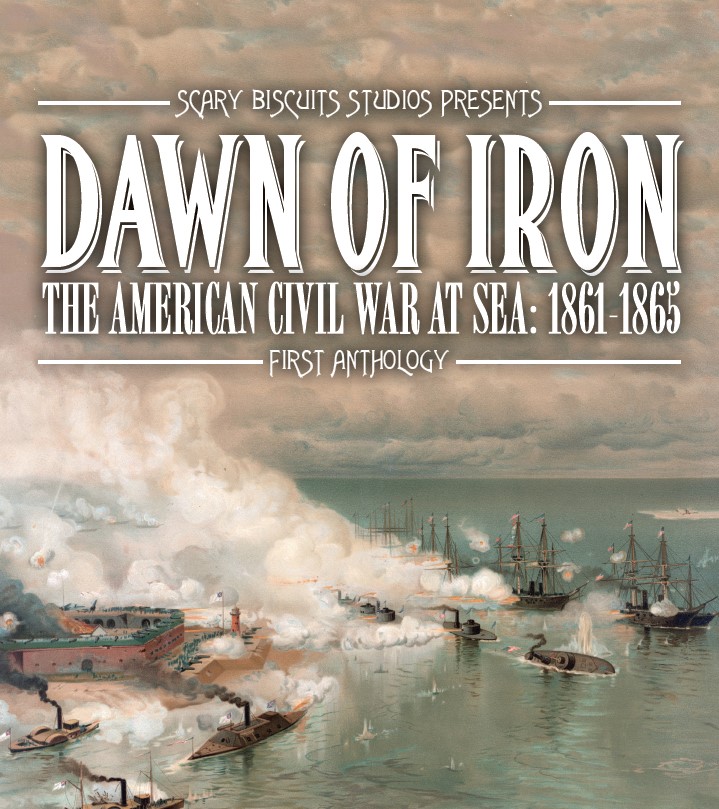
Dawn of Iron is a ruleset released in PDF format by Scary Biscuit Studio over the last two years. It started in beta for quite a bit, taking in player feedback and working through issues and historical accuracies. Mike Haught is the author. Right now it can be had on Wargame Vault for $9 (on sale, usually $19.00). I printed mine out and had it bound at Kinko’s. You can see my previous review of the rules here – however that was in a beta state of the rules so some things have changed.
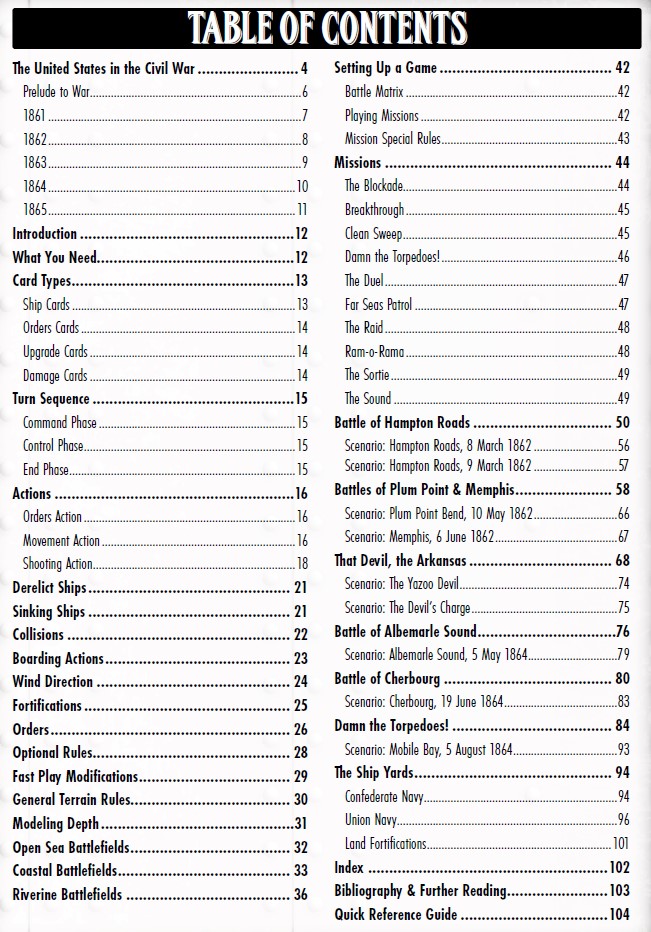
The Rules
Dawn of Iron clearly takes inspiration from a number of different sources. It uses damage card and upgrade card decks similar to X-Wing. It uses ship cards similar to many other games. You’ll notice these inspirations when you first start reading the rules, and the author is not shy about saying it.
Dawn of Iron is unashamedly inspired by many games and you probably will not have to go far to spot my key infl uences. But, like all designers, I carefully curated these mechanics and weaved themtogether. I did this to tell a very specifi c story and equip players with tools to continue exploring beyond these pages and connect with new stories of their own.
DoI is an alternating activation game. It isn’t based on pilot skill or vehicle speed or anything – it’s just player’s choice. Each player will have a fleet – this can be entirely historical, based on a scenario (of which there are quite a few in the rulebook and elsewhere) or you can use points to make equal fleets. DoI uses D6s.
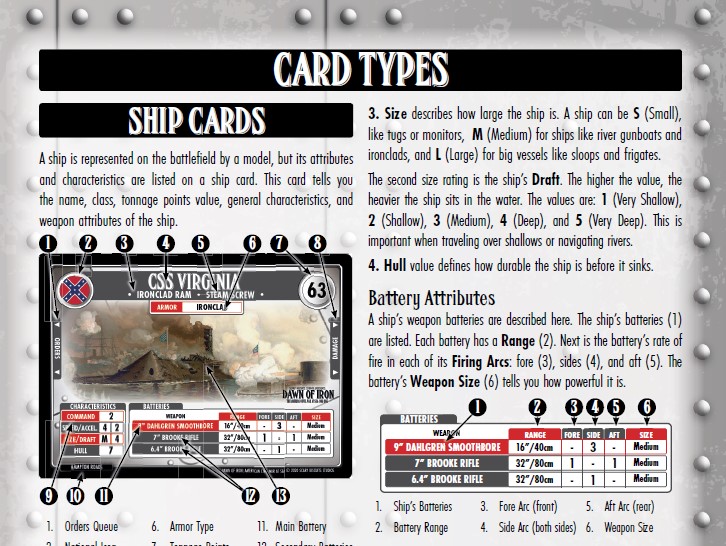
Each ship will have a card that shows their key characteristics and guns available. It’ll tell you if it’s an Ironclad, Tinclad, Timberclad, Cottonclad, or Wood. These types are available when it comes to damage against each ship. I went into more detail in my previous review – but for this one I’ll say the Command characteristic is an interesting differentiating factor. Each turn you assign a command card to each ship.
If you have Command 2, you have two cards in your queue, doing the first in first out method. You start the game with your queue filled, so you have to plan ahead if your Command value is higher. You don’t have to necessarily use a card if you put it in there, but they’re great bonuses.
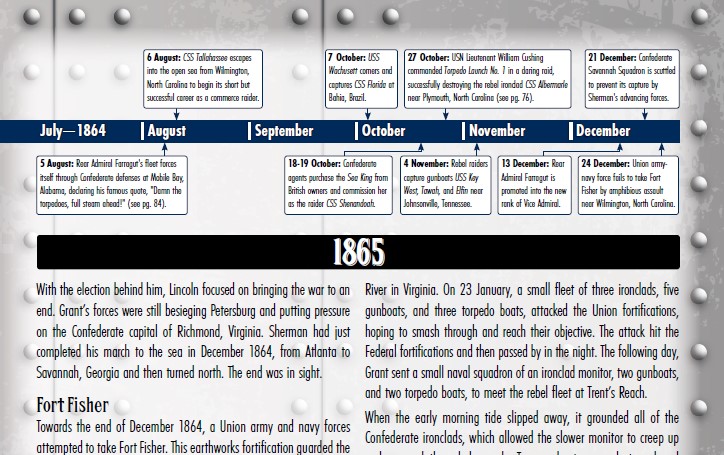
Each turn, you take turns activating a ship and doing an order, moving, then shooting. Each ship will have a current Speed value as you play, and ships will have to move a certain distance based on that speed. After each movement, you can either go faster or slower based on your acceleration rating. This causes some interesting times when ships get close to each other or you go through a narrow or shallow channel, as you can’t slow down and you might ram or go aground!
Shooting is easy – it takes into account ship size and silhouette (monitors are lower to the water, so they are harder to hit), range, ships being stationary, and other factors like fog etc. Ships get a chance to save if its possible (shooting a wood boat with a very heavy gun won’t allow a save). Getting closer or further away modifies the save as well, simulating the power of a cannonball when closer.
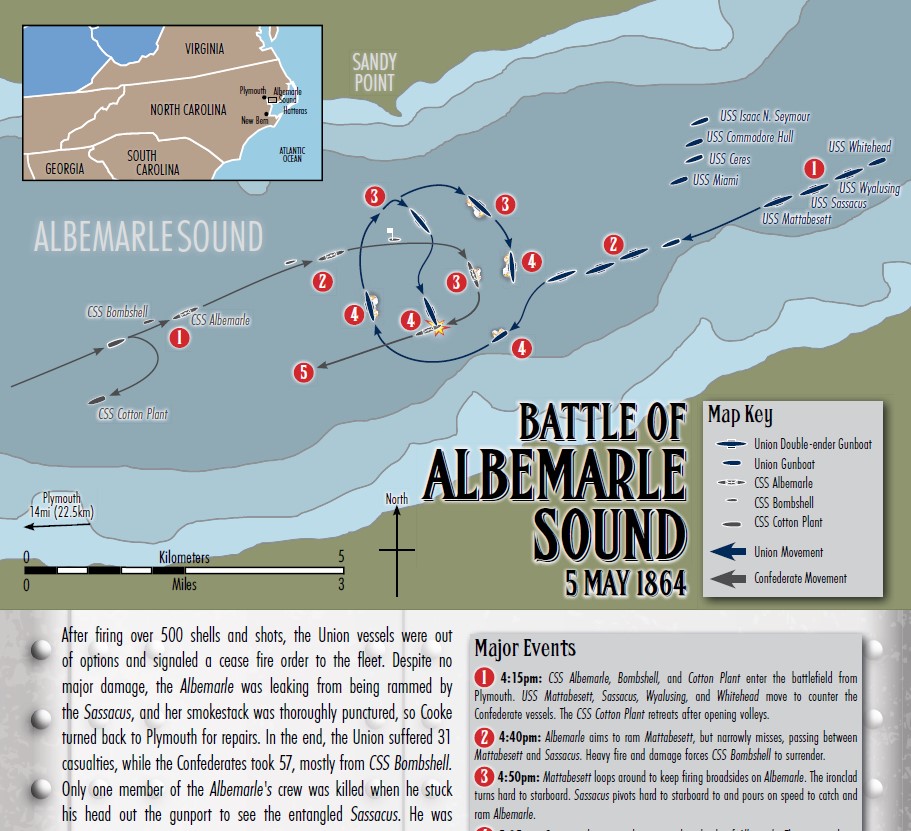
Damage cards will add up and disable your ship or destroy it outright. After a ship takes too much damage they begin to sink and will be debris in the area. It is possible to repair your ship if you roll well – but once you take Critical Damage you can’t repair those.
Overall, I love these rules. They’re easy to play, modern, and have layers of strategy that are important. There aren’t a ton of tables and things you have to look up. I taught players who had never played a naval game before in an hour and they had it down pretty well.
The Presentation
The rulebook and cards are gorgeous – they show a very experienced hand in graphic design. This is above and beyond what I expect when I buy a rulebook in 2022. Cards are laid out in PDF so you can print them and cutout, or have them printed at a card printing site. The rulebook clocks in at around 100 pages, but much of that is history or scenarios. The actual rules are around 30 pages.
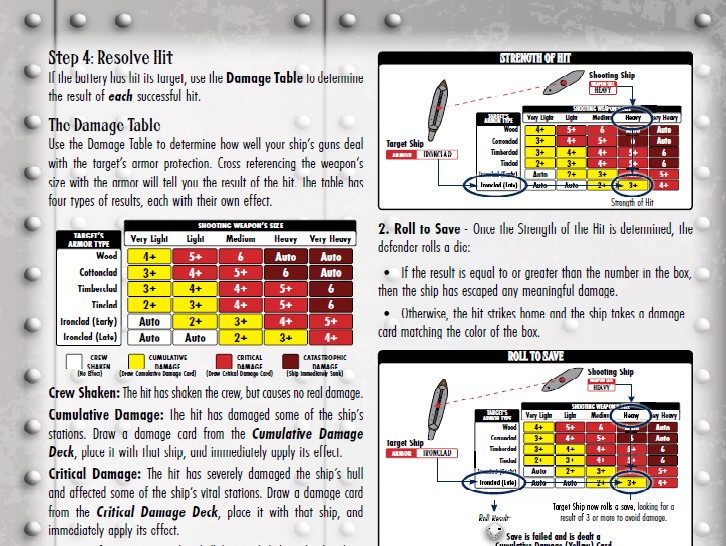
The Accessories
Dawn of Iron comes with ship cards, tokens, scenarios, damage cards, order cards, etc. They’re well laid out and work really well. The only issue I have is that not every ship I have is in the cards – but the author is quick to work with people to create cards in the system for ships they might have.

Sail and Steam Navies
S&S Navies is another PDF ruleset published in 2010 available on Wargame Vault for $19.99. I was recommended this game at a local con when I mentioned that I couldn’t find an ACW naval ruleset that I liked. I’m glad I checked it out! It’s a comprehensive ruleset that I will definitely be using.
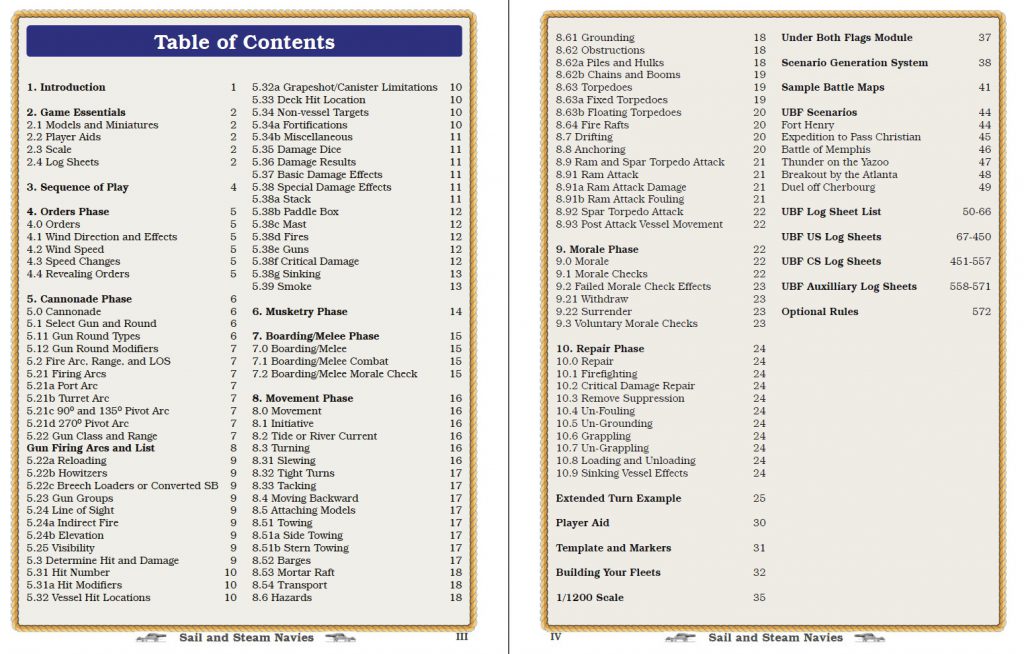
The Rules
S&S is an interesting ruleset in that it is not strictly alternating activation or IGOUGO. Some phases are simultaneous, which is really cool. The round starts with players secretly noting the speed of their ship on their ship card. Each turn a vessel can speed up based on how much of it’s Maximum Speed is left (it can take damage to this from cannon rounds). They can also slow down any number of speed boxes.
After all players have marked their orders, they shoot with their cannons and muskets if available. It’s interesting because this is done simultaneously – there is no first turn advantage here. Guns are typed into groups and each group has a close, medium, and long range, telling you the Hit Number. The hit die target is modified by various conditions including the status of the firer, movement, etc. If the ship is hit you consult the location die to see where it is hit. If the roll is a hit, you subtract the armor from the gun rating. The result is the number of damage dice that are rolled, always rolling at least one.
Movement is done by each side moving all their ships – so I move all mine, then you move all of yours. This is based on an initiative roll that has modifiers for speed and quality.
The one thing that surprised me about this ruleset was that there is a morale section. To be honest I didn’t expect it as I hadn’t seen it in other naval rulesets. It makes sense, for sure, and I think others just abstract it as damage etc. I like the inclusion of it here.

The Presentation
This ruleset is another more modern ruleset than some I’ve looked at – it’s clearly designed by someone who has experience with graphic design. It’s full color, with tons of great diagrams and examples.
There is an extended turn example with diagrams that is four pages long – I love this as I am always wondering exactly how a game works. I can’t overstate how great this is in a rulebook. There is also a one page QRS that is shown in order of play that really helps a ton.

The Accessories
This might be the strongest part of S&SN. There are log sheets (ship cards, basically) for 768 US ships, 211 Confederate ships, and 28 auxiliary selections. If there is a ship you read about once in a letter from your fifth great uncle then it is likely here. The ship logs are gorgeous, too. They have a diagram of the ship, boxes to mark off for damage (I’d recommend laminating the cards and then using a water erase marker), all the details of where it served, and gun values. They’re amazing.

The author also created counters for each ship that you can purchase for a nominal fee ($3.45 for each type of ship – so 98 ironclad monitors and ironclads, or 173 paddle gunboats & steamers). If you’re just looking to try out the game or don’t want to paint models then you can print these out and have them laminated, or attach them to cardstock or wood or anything and make a beautiful 2D game.

Hammerin’ Iron
Hammerin’ Iron is a ruleset updated in 2011 that is available in print (£16) from Peter Pig. They also have it available in PDF for £9. It was first published in 1985. This was the first ruleset I checked out and one of the most mentioned on the web.
The thing that I think differentiates HI from the others is that it’s a hex based movement system. Players can purchase a hex mat from PP (or make their own) or there is a system for putting a hex out when you move and then picking it up after.
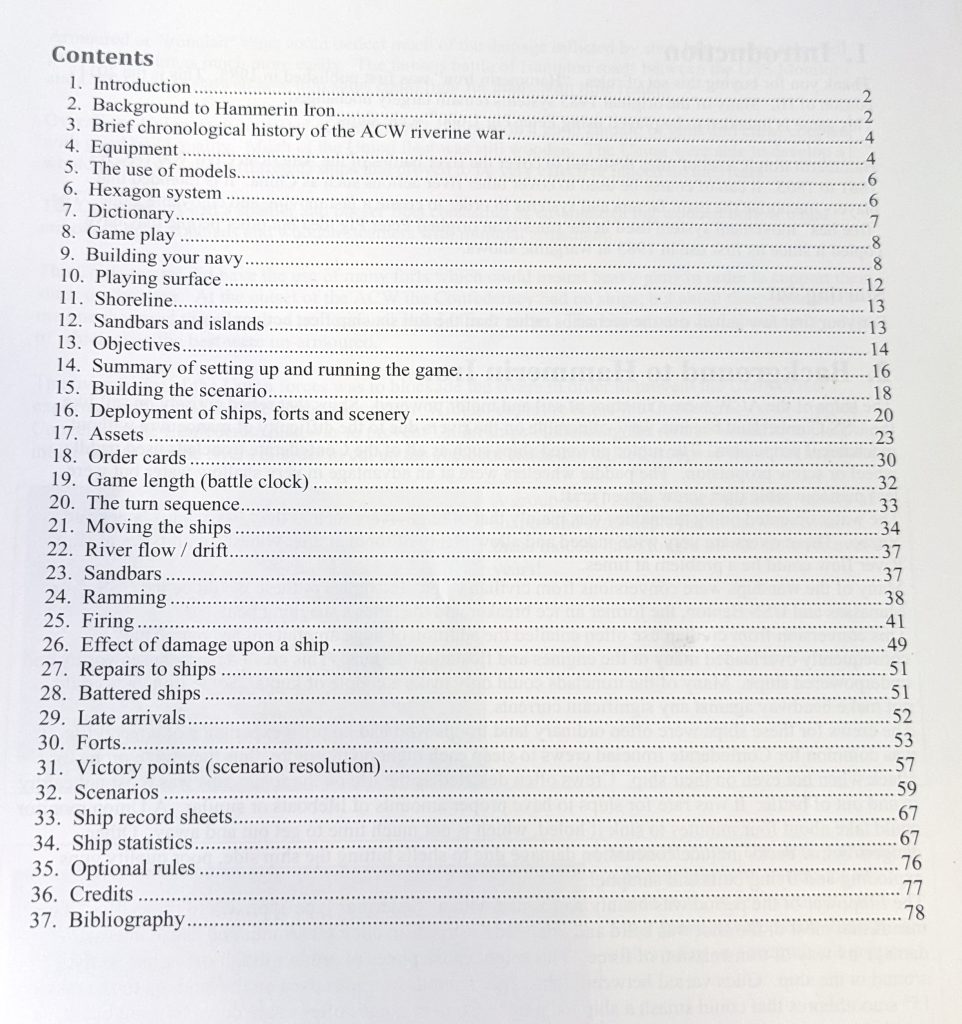
The rules, with scenarios and everything, come out to about 80 pages – but the pages have bigger margins and that does include ship stats so I wouldn’t be intimidated. There are also a fair number of optional or circumstantial rules.
[Authors note: my photos here of the rules are photos, not scans, as I don’t have the PDF and didn’t have access to a scanner. I feel that is necessary to mention, as the other photos in this article are all from PDFs and higher quality.]
The Rules
One of my favorite things about this game is that it is setup from the start to be an adversarial ‘matched play’ type of game if you wish.

The other games have points, but this ruleset actively looks for balance by giving you a ship total (six) and you must bring a fort. I think this will help players bring a cool variety of ships – but you can still keep it historical if you wish.

There are ship listings and point costs in the back of the book, but the author has actually given you the ability to create your own ships here with a point guide. You can also shave hit points off your ship to save some points, indicating that maybe on the way to the battle they struck a rock or lost some of the crew to a sickness. The other way to make point total is by removing one or two guns – perhaps one got a bit wet last night and can’t be used.
Other indications of it being Matched Play show up when each player gets to place islands and sand bars. You bring them with you and the defender places them, then the attacker may get a chance to move them a bit. Objectives are placed as well, with the defender getting to possibly move them. There is a nice summary on pages 16 and 17 of pre-game setup like we’re used to with a lot of modern rulesets.
HI is always played as Attacker/Defender. The attacker always gets all six of their ships during a game. The defender doesn’t get to use all their ships – they get a fort that replaces a random ship. There’s a funny bit about this:
If a player is upset by not having all of his ships on the table then he needs to try to be the attacker or to become a more sophisticated and mature player of games.

When a ship arrives on the table the owning player selects five order cards for it. You put the orders in a stack and may look at them, but they stay with that ship. The deck of orders you have is only 32 cards, so each ship will have five of those when it starts on the board. This means that you may have orders that you don’t wish to have in there for that ship at a certain time – but you have to use them, representing communication failure or mechanical issues. That’s friction, folks! Once a ship only has one card left you can re-do the stack.

Movement is done using hexes, according to the order you laid down that turn. You can turn your ship by putting a hex to the right or left of your ship. At full speed, normal ships can move 2 and fast ships can move 2 or 3 hexes.
Guns have a range of 5 hexes at long range or short range of 1 hex. There is an opportunity firing mechanic that I find very interesting – in short, it’s possible to fire at a target when they float in front of you, but you have to roll to see how many guns can do it.
Firing is rather simple – you fire each gun individually (the author mentioned that the players should get a ‘feel’ for the independence of each gun). There are a number of factors that will influence the number of dice rolled, but you start with 4D6. 5s and 6s hit the target. The target can then try to deflect the hits – for ironclads, you can deflect medium guns on a 4,5,6 and for tinclads you an deflect on a 5,6. Ships take critical damage as they reach or pass through a multiple of 5 hit points.
I tend to like this method as a con type game because you don’t have to track locations or anything like that. The hit points abstract everything and make it fast and easy.
Games of HI have a total of eight turns. Each turn it’s actually possible for a player to reduce the current turn number by one or advance it by one if they roll well in a certain phase. I think that’s really interesting, and another example of friction!
The Presentation
Being a somewhat older ruleset, the rules do lack a little bit of the pizazz. It’s in black and white and the pictures are all photos from the game, not art. It is presented in an outline format, which a lot of wargamers are used to. I do love that you can buy it printed – you don’t have to mess around at Kinko’s or use DriveThru. I also really love that the author put some real personal flavor into the text, oftentimes including notes and funny anecdotes.

The Accessories
This is a strong point for HI. Peter Pig sells a ton of 1/600 scale ships at great prices. They also sell the mat that you need to play the game. They have great models of the forts, town pieces, etc that you might need. I don’t have their tokens yet but do intend to get some.
That’s it for our rules roundup for ACW naval games – check back in next week for more Historical goodness!


